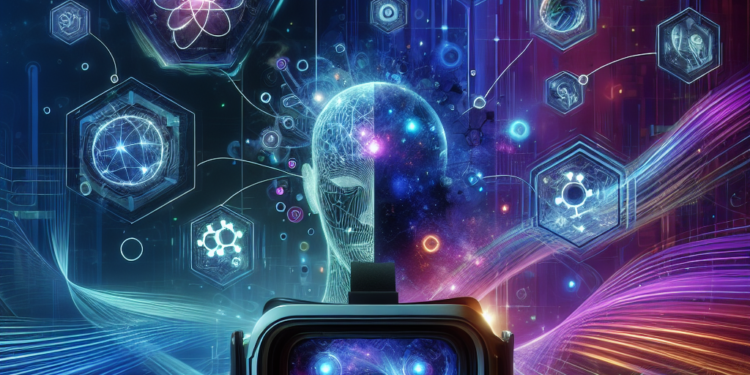Artificial Intelligence (AI) has revolutionized the way we interact with technology, paving the way for innovative advancements in various fields. One such field that has benefitted greatly from the integration of AI is Virtual Reality (VR). AI tools have enhanced VR experiences by providing immersive, interactive, and personalized environments for users.
In this article, we will explore the various AI tools that have contributed to enhancing Virtual Reality and revolutionizing the way we interact with virtual environments.
1. Natural Language Processing (NLP): NLP is a branch of AI that focuses on enabling machines to understand and interpret human language. In the context of Virtual Reality, NLP allows users to interact with virtual environments using natural language commands. This means that users can communicate with virtual characters, objects, and environments using spoken or written language, creating a more immersive and personalized experience.
NLP can also be used to enhance VR applications by enabling real-time translation of languages, allowing users to communicate with people from different parts of the world seamlessly. This makes VR experiences more inclusive and accessible to a wider audience.
2. Computer Vision: Computer Vision is another AI tool that has transformed Virtual Reality experiences. Computer Vision enables machines to interpret and analyze visual information, allowing them to recognize objects, patterns, and gestures in real-time. In VR applications, Computer Vision can be used to track users’ movements, gestures, and facial expressions, allowing for more interactive and responsive virtual environments.
Computer Vision can also be used to create more realistic and immersive visuals in VR applications by enhancing graphics, textures, and lighting effects. This creates a more engaging and realistic experience for users, making them feel like they are truly immersed in the virtual world.
3. Machine Learning: Machine Learning is a branch of AI that focuses on enabling machines to learn from data and improve their performance over time. In the context of Virtual Reality, Machine Learning can be used to personalize and customize VR experiences based on users’ preferences, behaviors, and interactions.
Machine Learning algorithms can analyze user data, such as browsing history, past interactions, and feedback, to provide personalized recommendations and suggestions for VR content. This enables users to discover new and relevant content that aligns with their interests, creating a more engaging and immersive experience.
Machine Learning can also be used to enhance the realism and interactivity of virtual environments by predicting users’ actions and adapting the environment accordingly. This creates a more dynamic and responsive VR experience that feels personalized and tailored to each user.
4. Sentiment Analysis: Sentiment Analysis is a branch of AI that focuses on analyzing and interpreting human emotions and attitudes through natural language processing. In Virtual Reality, Sentiment Analysis can be used to track users’ emotions and reactions in real-time, allowing developers to tailor the VR experience based on users’ emotional responses.
Sentiment Analysis can be used to create more engaging and interactive virtual environments by adapting the content, music, lighting, and other elements based on users’ emotional states. For example, if a user is feeling stressed or anxious, the VR environment can adjust to provide calming and relaxing content to help increase the user’s comfort and enjoyment.
5. Personalization and Recommendation Systems: AI-powered recommendation systems have become a pivotal tool in enhancing Virtual Reality experiences. These systems use Machine Learning algorithms to analyze user data, preferences, and behaviors to provide personalized recommendations for VR content, games, and experiences.
Personalization and recommendation systems can help users discover new and relevant VR content that aligns with their interests and preferences. This not only enhances the user experience but also helps developers and content creators to reach a wider audience and increase user engagement.
6. Dynamic Content Generation: AI tools can also be used to generate dynamic and personalized content in Virtual Reality applications. By leveraging Machine Learning algorithms, developers can create dynamic and responsive virtual environments that adjust in real-time based on user interactions, preferences, and behaviors.
Dynamic content generation allows for more engaging and interactive VR experiences by providing users with personalized and tailored content that adapts to their actions and choices. This creates a more immersive and immersive experience that feels unique and personalized to each user.
7. Predictive Analytics: Predictive Analytics is another AI tool that has transformed Virtual Reality experiences by enabling developers to forecast user behaviors, trends, and preferences. By analyzing user data and interactions, developers can predict user actions and preferences to create more engaging and relevant VR content.
Predictive Analytics can be used to optimize VR experiences by identifying patterns and trends in user data, allowing developers to improve user engagement, retention, and satisfaction. This helps developers to create more successful and immersive VR applications that resonate with users and keep them coming back for more.
In conclusion, AI tools have greatly enhanced Virtual Reality experiences by providing more immersive, interactive, and personalized environments for users. From Natural Language Processing and Computer Vision to Machine Learning and Sentiment Analysis, AI tools have revolutionized the way we interact with virtual environments, creating more engaging and realistic VR experiences. By leveraging these AI tools, developers can create dynamic and responsive virtual environments that adapt to users’ preferences, behaviors, and emotions, creating a truly immersive and personalized experience for users.













